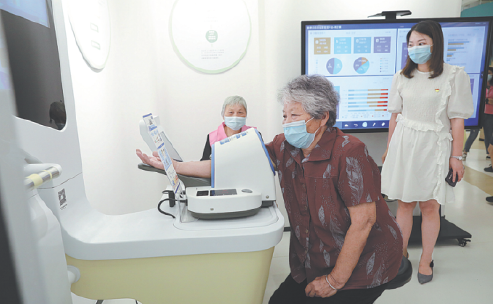Health within reach

A woman checks her blood pressure in a self-service testing area. ZHU XINGXIN/CHINA DAILY
Local communities benefit from latest investments in convenient, high-tech medical services
Editor's note: With its people-centered philosophy, China will build the eastern province of Zhejiang into a demonstration zone for achieving common prosperity. This series looks at the latest steps taken in various areas to meet that goal.
Several times a week, Yang Jinbao, 78, takes a brief stroll from her home to see her family physician.
"We keep track of her condition carefully," physician Zhang Liqiang said. "She has high blood pressure, and that can actually go up after a 20-minute walk, so it's really good that she's close by."
Zhang is a doctor at the "intelligent health center" in Yaozhuang township of Jiashan county in Jiaxing, Zhejiang province.
The center is a community medical facility where visiting hospital doctors such as Zhang attend to patients. Yang and others in the community have access to state-of-the-art healthcare equipment and services, including digital diagnostic systems, artificial intelligence robotic assistants, integrated biometric medical records and prescription delivery networks. Residents can also participate in tai chi and other wellness programs and activities.
"I check in as much as I can. I also get advice on my dietary needs and lifestyle in general," Yang said.
Wang Lijun, deputy head of Yaozhuang township, said, "This intelligent facility, which covers the 20,000 residents of the local community, is a one-stop center for health services and acts as our first line of defense, because good health starts with daily, healthy living and disease prevention."
The center is a building block of Jiashan county's major medical development drive, bringing together advanced health capabilities to form an urban-rural loop of prevention and treatment services. This is in line with the nation's "Healthy China 2030 Initiative", which aims to boost public health services and related sectors over the next decade.
The city of Jiaxing is already at the forefront of implementing a wide range of measures to foster common prosperity in the next crucial stages of the country's inclusive development.
In August, a meeting chaired by President Xi Jinping of the Central Committee for Financial and Economic Affairs outlined steps to promote common prosperity via high-quality growth, using a phased approach to reach the target.
Zhejiang, one of China's most-developed provinces, has been designated a demonstration zone to explore a new path for common prosperity and to show how the country can tackle unbalanced and inadequate development.
The province has a target of achieving common prosperity by 2035, with its per capita gross domestic product and the income and standard of living of urban and rural residents reaching those of developed countries.
Healthcare and medical services form an integral part of the drive for common prosperity. In Jiashan, a two-year effort to integrate and share rural-urban capabilities now includes at least five county-level hospitals and more than 100 community health service centers and stations.
The latest investments in the medical sector include more than 3 billion yuan ($470 million) for hospitals as well as women's and children's facilities, disease control and prevention centers and blood stations, and nearly 40 million yuan annually for medical subsidies and incentives, equipment upgrades and grassroots programs, according to county authorities.
Digital progress
Digitalization is a significant part of Jiashan's medical services push under the Healthy China 2030 plan. According to the county government, at least 18 major projects totaling 10 billion yuan have been rolled out for "full use of digital means to improve the level of medical and health services by digital empowerment, and enhance the experience of and access to medical treatment by intelligent means".
Wu Xuan, head of Jiashan's health bureau, said the county is comprehensively investing in medical care, with an emphasis on the prevention of chronic illnesses in rural communities.
"Our residents may find it difficult to access the advanced healthcare in nearby big cities, so we are fully tapping high-tech, digital platforms to narrow the gap," Wu said.
"We're using big data to keep track of the health trends among residents, reporting their ailments, treatments and progress. We're building the facilities and networks to bridge medical services in the cities and villages."
Biodata and information on villagers' health and medical needs are stored on digital platforms and easily accessed, including via smartphone apps. This allows healthcare professionals to coordinate diagnosis and treatment through virtual networks assisted by AI speech recognition and other high-tech channels, Wu said. This effectively overcomes physical and geographical barriers for medical services, he added.
Smartphone apps help residents "pick a suitable doctor to consult", and they can check their healthcare profiles after online consultations, Wu said. "We can say that the residents have a 24-hour health manager."
Jiashan has set up health profiles for about 540,000 people, including residents and people from other areas, giving the county a health profile rate of nearly 92 percent, Wu said.
Bureau deputy head Chen Yuefeng said the county is focusing on medical "hardware and software" for inclusive growth.
"Health is wealth. We attract doctors and other specialists to spend time in the community hospitals and centers, reaching out to the grassroots," Chen said.
Recognizing the importance of drawing medical professionals and other talent to its facilities, the county offers work, training and research incentives and programs, including individual subsidies of up to 1.58 million yuan. More than 30 high-level healthcare specialists have headed to Jiashan since last year, an increase of more than 30 percent year-on-year.
The digital drive is also expanding the virtual network, such as by linking at least 37 hospitals in the Yangtze River Delta area with leading intelligent medical facilities, including the virtual consultation room of Shanghai Children's Hospital, which has remote reading, diagnosis and treatment capabilities.
Wu Lianghua, who directs a 70-member, 7,000-square-meter community medical center that has 68 beds, said facilities like his mean villagers are just 15 minutes away from any basic healthcare consultation or treatment.
"We have rehabilitation services. Our doctors and professionals from major hospitals also make their rounds here, and we can refer and direct patients efficiently to the appropriate care," Wu said.
Kong Chuifeng, deputy director of the county health bureau, said: "The three-tier medical network includes county, town and village. We are building mobile medical stations within community services. We set up a mobile station in every community. Every week, medical staff go to patients' homes to deliver medicine.
"We're seeing real results from these efforts. The residents enjoy the convenience of healthcare at their doorstep. They are also able to get regular house calls if needed. Costs are also lower because of the localization of services," he said.
Other achievements resulting from Jiashan's healthcare investments include a maternal mortality rate of zero per 100,000 live births, a neonatal mortality rate of 0.88 per 1,000 live births, and an infant mortality rate of 1.32 per 1,000 live births last year-all significantly lower than provincial health indicators. By June this year, the county reported at least 670,000 digital health records showing improvements among residents in such symptoms as high blood pressure, with life expectancy at 84.07 years.
The figures helped the county receive national accolades for its disease and trauma management efforts and hospital services in the past year.
As part of the latest prevention and control measures amid the COVID-19 pandemic, fever clinics and facilities for treatment, infusion observation, CT scans and lab testing, as well as isolation operation rooms, have been put in place, with at least 20 million yuan invested.
Through its multilevel approach, the county aims to utilize the latest medical and health developments, effectively responding to changing public health needs by improving the service level, quality and performance management of primary medical institutions.
Yu Chunsong, who leads a team of county first responders within the provincial emergency medical services network, said his front-line work reflects the major improvements in the field and the increasing focus on healthcare at the local level.
'Regular training'
"Our stations each cover an average service radius under 3 kilometers, with response times achieving eight minutes or less. Our personnel receive regular training, and we have fully equipped facilities and emergency vehicles, with at least one ambulance for every 30,000 residents," he said.
To help integrate first-aid capabilities and further narrow the gaps in rural-urban medical services, 100 million yuan has been invested in the past two years to equip emergency units with at least 21 ambulances, advanced mobile CT scanners and newborn and cardiac treatment devices.
In addition, about 20,000 residents a year participate in first-aid training sessions, thereby continuously improving the ability of members of the public to help themselves, according to county health authorities.
"From the first contact with patients' health condition to helping them to a hospital for any needed treatment, our medical services are close on the ground and kept at the forefront," Yu said.
Contact the writers at alexishooi@chinadaily.com.cn


 Red boat spirit inspires new developments
Red boat spirit inspires new developments Zhejiang: A Decade of Progress
Zhejiang: A Decade of Progress A look at Jiaxing's H1 economic data
A look at Jiaxing's H1 economic data